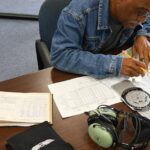American Flyers has been training and supporting pilots since 1939. Throughout this time, we have trained more instrument pilots than anyone else in the industry. Many years ago, American Flyers condensed this knowledge and experience and published a “how to” guide for instrument pilots. This manual is called “Single Pilot in the IFR Environment” or SPOIFRE.
FORECAST RELIABILITY
Some comments on the reliability of forecasts are in order. The accuracy of a forecast is limited by two major things— what is known and what can be measured. These elements determine the reliability factor. The reliability factor of weather forecasts is inversely proportional to the length of time that has passed since the forecast was issued.
Forecasts of GOOD weather are likely to be correct for up to twelve hours. Unfortunately, a forecast of BAD weather is NOT likely to be correct for the same period of time. Ceiling and visibility forecasts are not reliable beyond two to three hours. In other words, a twelve-hour forecast of good weather has a reliability factor of about 80 percent, whereas a twelve-hour forecast of bad weather is only about 45 percent reliable.
In cases where distinct weather systems are involved, such as fronts, precipitation, etc., there is a tendency to forecast too little bad weather.
Errors in forecasting the time of a specific weather occurrence are more prevalent than errors in forecasting the occurrence itself. Some high-reliability forecasts, which are usually about 75 percent correct, are:
Passage of fast-moving cold fronts within plus or minus two hours; a passage of slow-moving warm fronts within plus or minus five hours; rapidly lowering ceilings in pre-warm front conditions are accurate to within plus or minus 200 feet, to within a time accuracy of plus or minus four hours. In areas where radar is available, the forecast of thunderstorms is accurate to within one to two hours.
Unfortunately, the lowest reliability forecasts are for the two major hazards to aviation: the location of severe turbulence and thunderstorms (before they are formed) and the location and occurrence of icing.
PIC DECISION MAKING
Now is the time the pilot makes his go or no-go decision. If the decision is a go, a route log should be prepared in order to obtain enroute times and other information required for the flight plan. This is a procedure and therefore, mandatory. The type and complexity of the route log is technique and will vary depending on the pilot’s proficiency and the type of equipment being used. In any case, the Winds Aloft Forecast is necessary not only for estimating ground speeds, but also as a factor in selecting an altitude (see figure below – Ground Speed Made Easy) shows a method for quickly calculating the ground speed for various legs of the flight.
On any given course, if the wind is on the nose of the airplane, the full value of the wind is subtracted from the planned true airspeed. For example, if the true airspeed is 100 knots and there was a 20-knot headwind, the groundspeed would be 80 knots. If it is a quartering headwind, one-half the value of the wind is subtracted. If it is a direct crosswind, one-fourth the value of the wind is subtracted. If this method is used to calculate ground speed during an approach, because of the short distances involved, a direct crosswind can be disregarded. For a quartering tailwind, one-half of the wind value is added, and for a direct tailwind, the full wind value is added to the true airspeed in order to obtain ground speed.
The two figures below (Route Log) and (Flight Planning WX) show a route log. Having an “adequate” route log is procedure. What constitutes an “adequate” route log is technique. Some pilots make a few scratches on the enroute chart and that’s all. However, if called upon for an estimate, they come right up with the information. For those people the scratches are “adequate,” however, most pilots need more. An adequate route log is one that contains all the information needed to plan a flight. It will reduce chart reference, (a must item for a single-pilot IFR operation). It will provide the information needed to make the required reports and it will furnish the data necessary should a communications failure occur one that contains all the information needed to plan a flight. It will reduce chart reference, (a must item for a single-pilot IFR operation). It will provide the information needed to make the required reports and it will furnish the data necessary should a communications failure occur.










